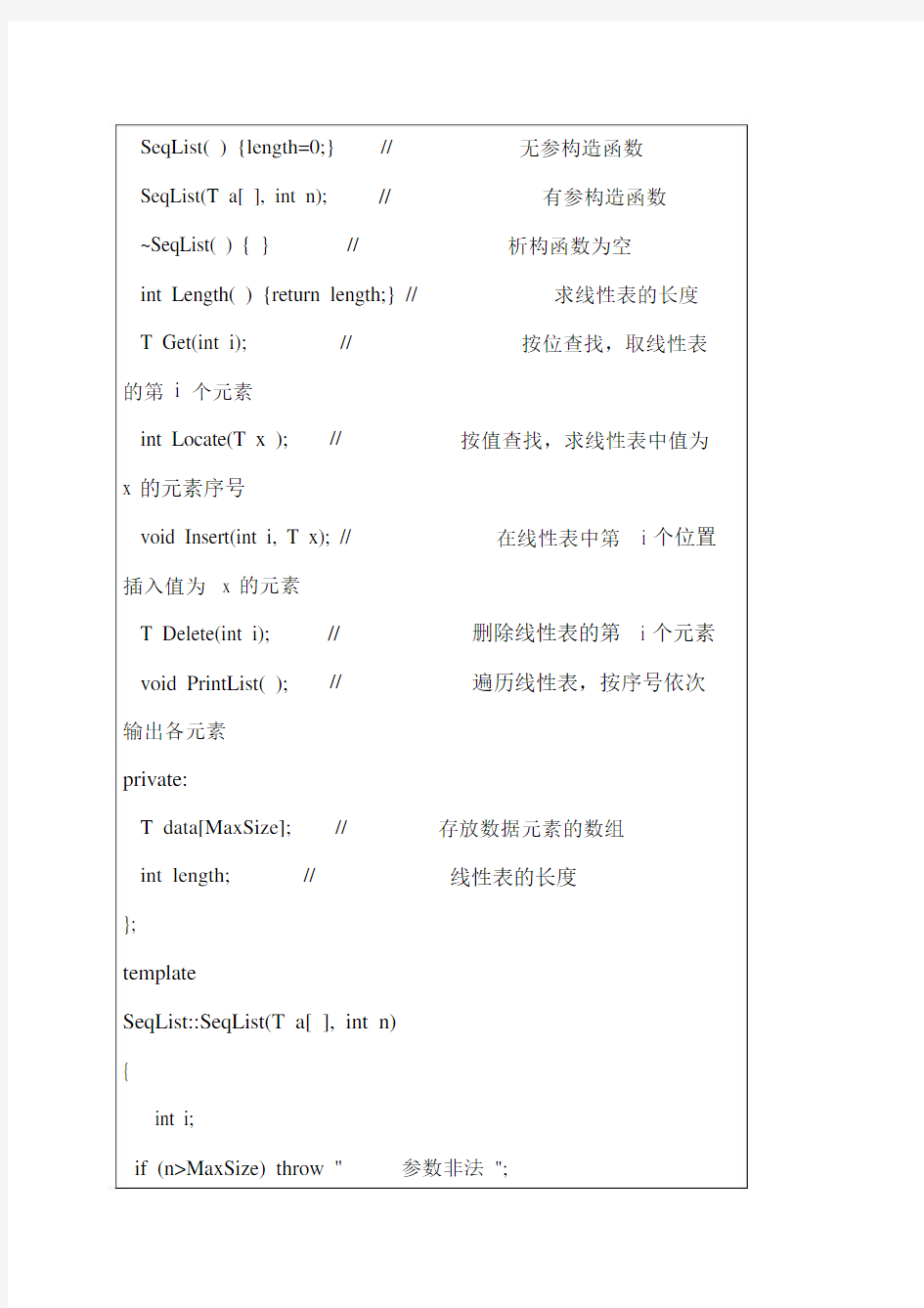

实验一类和对象实验课程名:面向对象程序设计(C++)
专业班级:学号:
实验时间:实验地点:姓名:
指导教师:
一、实验目的和要求
(1)理解类和对象的概念,掌握声明类和定义对象的方法。
(2)掌握构造函数和析构函数的实现方法。
(3)初步掌握使用类和对象编制C++ 程序。
(4)掌握对象数组、对象指针和string 类的使用方法。
(5)掌握使用对象、对象指针和对象引用作为函数参数的方法。
(6)掌握类对象作为成员的使用方法。
(7)掌握静态数据成员和静态成员函数的使用方法。
(8)理解友元的概念和掌握友元的使用方法。
二、实验内容
1.设计一个静态数组存储结构的顺序表类,要求编程实现如下任务:建立一个线性表,首先
依次输人数据元素1,2,3,?,10,然后删除
数据元素 6,最后依次显示当前线性表中的数
据元素。要求采用顺序表实现,假设该顺序表
的数据元素个数在最坏情况下不会超过50个。实验代码: #include
using namespace std;
const int MaxSize=100; //100只是示例性的数据,可根据
实际问题具体定义
template
class SeqList
{
public:
SeqList( ) {length=0;}//无参构造函数SeqList(T a[ ], int n);//有参构造函数
~SeqList( ) { }//析构函数为空
int Length( ) {return length;} //求线性表的长度T Get(int i);//按位查找,取线性表的第i个元素
int Locate(T x );//按值查找,求线性表中值为x 的元素序号
void Insert(int i, T x); //在线性表中第i 个位置插入值为x 的元素
T Delete(int i); void PrintList( );//
//
删除线性表的第i 个元素
遍历线性表,按序号依次
输出各元素private:
T data[MaxSize]; int length;////存放数据元素的数组
线性表的长度
};
template
SeqList
{
int i;
if (n>MaxSize) throw "参数非法";
for (i=0; i data[i]=a[i]; length=n; } template T SeqList { if (i<1 && i>length) throw "查找位置非法"; else return data[i-1]; } template int SeqList { int i; for (i=0; i if (data[i]==x) return i+1; //下标为i的元素等于x,返回其序号i+1 return 0;//退出循环,说明查找失败 } template void SeqList { int j; if (length>=MaxSize) throw "上溢 "; if (i<1 || i>length+1) throw " 位置 "; for (j=length; j>=i; j--) data[j]=data[j-1];//注意第j个元素存在数组下标为j-1 处 data[i-1]=x; length++; } template T SeqList { T x; int j; if (length==0) throw "下溢 "; if (i<1 || i>length) throw " 位置 "; x=data[i-1]; for (j=i; j data[j-1]=data[j]; //注意此处j已经是元素所在的数组下标 length--; return x; } template void SeqList { int i; for(i=0;i cout< cout< } int main() { int m,n,t; int a[10]={0,1,2,3,4,5,6,7,8,9}; SeqList SeqList p=&seq; cout<<" 线性表的长度为: "< p->PrintList(); cout<<" 请输入要查找元素的位置 :"< cin>>n; cout<<" 您所要找的元素为:"< cout<<" 请输入要查找的元素值: "< cin>>n; cout<<" 该值所在的位置为:"< cout<<" 请分别输入插入位置与要插入的元素"< cin>>n>>t; p->Insert(n,t); p->PrintList(); cout<<" 请输入要删除的元素所在的位置:"< cin>>n; p->Delete(n); p->PrintList(); return 0; } 运行结果: 2.设计一个带头结点的单链表类,要求: (1)生成一个整数线性表,实现将其分解成两个链表, 其中一个全部为奇数,另一个全部为偶数(尽量利 用已知的存储空间)。 (2)设计一个测试主函数,实际运行验证所设计单链表类的正确性。 实验代码: #include using namespace std; template struct Node { T data; Node }; template class LinkList { public: LinkList( ){first=new Node 建立只有头结点的空链表 LinkList(T a[ ], int n); //建立有 n 个元素的单链表 ~LinkList( );//析构函数 int Length( );//求单链表的长度 T Get(int i);//取单链表中第i 个结点的元素值 int Locate(T x);//求单链表中值为x 的元素序号void Insert(int i, T x); //在单链表中第 i 个位置插入元素值为 x 的结点 T Delete(int i);//在单链表中删除第 i 个结点void PrintList( );//遍历单链表,按序号依次输出各元素 Node }; template LinkList { int i; Node first=new Node first->next=NULL; // 初始化一个空链表 for (i=n-1; i>=0; i--) { s=new Node s->next=first->next;//插入到头结点之后 first->next=s; } } template LinkList 析构函数 { Node p=first; while(p) { q=p; p=p->next; delete q; } } template int LinkList 求链表的长度 { int i=0; Node p=first; while(p) { p=p->next; i++; } return i-1; } template T LinkList { int n=0; Node p=first; while(p&&i>n) { p=p->next; n++; } return p->data; } template int LinkList { int i; Node p=first; for(i=0;p;i++) { if(p->data==x) return i; p=p->next; } } template void LinkList 输出函数 { Node p=first->next; while(p) { cout< p=p->next; } cout< } template void LinkList { int n=0; Node p=first; while(p&&n { p=p->next; ++n; } q=new Node q->data=x; q->next=p->next; p->next=q; } template T LinkList int n=0; Node p=first; while(p->next&&n { p=p->next; ++n; } q=p->next; p->next=q->next; return q->data; delete q; } int main() { Node int a[10]={0,1,2,3,4,5,6,7,8,9}; LinkList 定义三个链表cout< p=L1.first->next,q=L2.first,r=L3.first; L2.first=new Node L2.first->next=NULL; L3.first=new Node L3.first->next=NULL; while(p)// 当链表 L1 中有元素时进行循环 { if(p->data%2==0)//当L1中的元素为偶数时插入L2 { q=new Node q->data=p->data; q->next=L2.first->next; L2.first->next=q; } else { r=new Node r->data=p->data; r->next=L3.first->next; L3.first->next=r; } p=p->next; } L1.PrintList( ); L2.PrintList( ); L3.PrintList( ); cout<<" 链表的长度为: "< cout<<" 链表的第四个元素为:"< cout<<"链表中元素 5 为第 "< "< L1.Insert(4, 17); cout<<" 插入元素后链表为:"; L1.PrintList( ); L1.Delete(8); cout<<" 删除第 8 个元素后链表变为:"; L1.PrintList( ); return 0; } 实验结果: 3.设计一个不带头结点的单链表类,要求: (1)不带头结点单链表类的成员函数包括取数据元素个 数、插入元素、删除所有值为k 的元素、取数据元素。 (提示:要考虑在第一个数据元素结点前插入和删除第 一个数据元素结点时与在其他位置插入和删除其他 位置结点时的不同情况。 ) (2)设计一个测试主函数,实际运行验证所设计循环单 链表类的正确性。 实验代码: #include using namespace std; template T data; Node }; template LinkList( ){first=new Node 建立只 有头结点的空链表 LinkList(T a[],int n); ~LinkList( ); int Length( ); // T Get(int i); // void Insert(int i, T x); // 求单链表的长度 取单链表中第 i 个结点的元素值 在单链表中第 i 个位置插入元素值 为 x 的结点 T Delete(int i); void PrintList( // ); // 在单链表中删除第 i 个结点 遍历单链表,按序号依次输出各 元素 private: Node 单链表的头指针 }; template LinkList int i=1; Node first=new Node for(i=1;i q=new Node q->next=NULL; p->next=q; p=q; } } template LinkList { Node p=first; while(p) { p=p->next; delete first; first=p; } } template int LinkList { int i=0; Node p=first; while(p) { p=p->next; i++; } return i; } template T LinkList { int j=1; Node p=first; while(p&&j { p=p->next; j++; } return p->data; } template void LinkList int j=1; Node p=first; while(p&&j p=p->next; j++; } q=new Node q->data=x; q->next=p->next; p->next=q; } template T LinkList { int j=1; Node p=first; while(p&&j { p=p->next; j++; } q=p->next; p->next=q->next; return q->data; delete q; } template void LinkList { Node p=first; while(p) { cout< p=p->next; } cout< } int main() { int a[10]={0,1,2,3,4,5,6,7,8,9}; LinkList cout<<" 链表长为: "< cout<<" 链表的第 6 个元素为: "< L.Insert(5,17); p=p->next; j++; } q=new Node q->data=x; q->next=p->next; p->next=q; } template T LinkList { int j=1; Node p=first; while(p&&j { p=p->next; j++; } q=p->next; p->next=q->next; return q->data; delete q; } template void LinkList { Node p=first; while(p) { cout< p=p->next; } cout< } int main() { int a[10]={0,1,2,3,4,5,6,7,8,9}; LinkList cout<<" 链表长为: "< cout<<" 链表的第 6 个元素为: "< L.Insert(5,17);